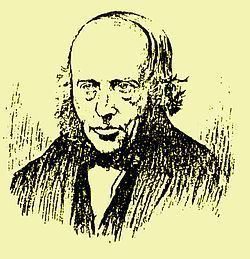Name Robert Davidson Role Inventor | ||
 | ||
Died 1894, Aberdeen, United Kingdom | ||
Robert davidson at the gordon smith gallery of canadian art
Robert Davidson (1804–1894) was a Scottish inventor who built the first known electric locomotive in 1837. He was a lifelong resident of Aberdeen, northeast Scotland, where he was a prosperous chemist and dyer, amongst other ventures. Davidson was educated at Marischal College, where he studied second and third year classes of Marischal College from 1819-1821 [1], including lectures from Professor Patrick Copland. He got this education in return for being a lab assistant.
Contents
- Robert davidson at the gordon smith gallery of canadian art
- Exhibitions
- Electric locomotives
- Economics
- Davidsons legacy
- Business
- References
In the 1820s he set up in business close to the Aberdeen-Inverurie Canal, at first supplying yeast, before becoming involved in the manufacture and supply of chemicals.[2]
He became interested in the new electrical technologies of the day. From 1837, he made small electric motors on his own principles, though William H. Taylor in the US made similar motors from 1838. Both men worked independently without knowledge of the other's work.
Exhibitions
Davidson staged an exhibition of electrical machinery at Aberdeen, Scotland in 1840, Edinburgh, one year later—where it was visited by the young James Clerk Maxwell and later at the Egyptian Hall in Piccadilly in London, where he hoped to attract sponsorship for his work.[3] Amongst the machines shown were electrically operated lathes and printing presses. Robert Davidson made the first car in 1839
Electric locomotives
Davidson made a model electric locomotive in 1837. His Galvani of 1842 was a four-wheeled machine, powered by zinc-acid batteries. It was tested on the Edinburgh-Glasgow line in September 1842 and, although found capable of carrying itself at 4 mph, it did not haul any passengers or goods.
Economics
In a later report it was calculated that consuming zinc in a battery was forty times more expensive than burning coal in a firebox and later experiments in America proved these figures correct. Battery powered locomotives were not economically viable, a point lost on some steam mechanics who smashed the 'Galvani' in its shed, fearing the potential competition to their new trade.
Financially viable electric traction was developed from the 1860s when the dynamo was invented and perfected. Davidson lived to see these developments: his reaction to the opening of the City & South London Tube was to commission a new set of business cards, that read 'Robert Davidson : Father of the Electric Locomotive'.
Davidson's legacy
He has been described as a forgotten hero and electrical visionary. He could not interest the rail companies; the technology he employed was too expensive. In 1840, the 'Aberdeen Banner' had predicted that the type of machinery he was producing "will in no distant date supplant steam"; however, it was only when electric locomotives were introduced in the 1890s that the media came to recognise what he had done. He was described as the "oldest living electrician" and 'The Electrician' magazine reported “ Robert Davidson was undoubtedly the first to demonstrate the possibility of electrical traction in a practical way”.
Business
After 1843, at home in Aberdeen, he settled down to family life and, for the next fifty years, the running of his business at Canal Road. His earlier invention of a method for large-scale production yeast, one of the staples of his chemical business, and the manufacture of perfumes were so remunerative that it allowed him to indulge his many interests of astronomy, collecting of fine china, valuable pictures and a large collection of violins.
